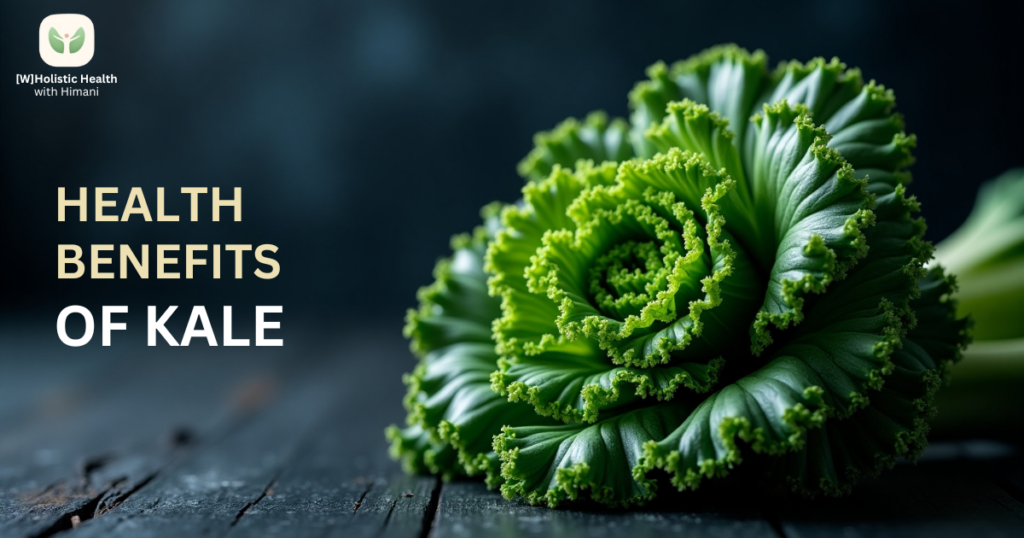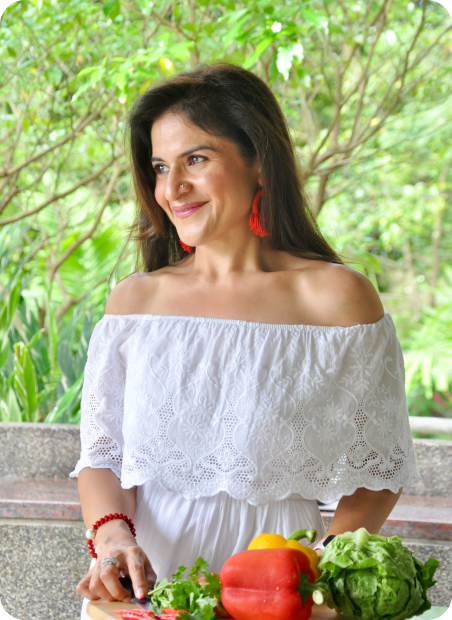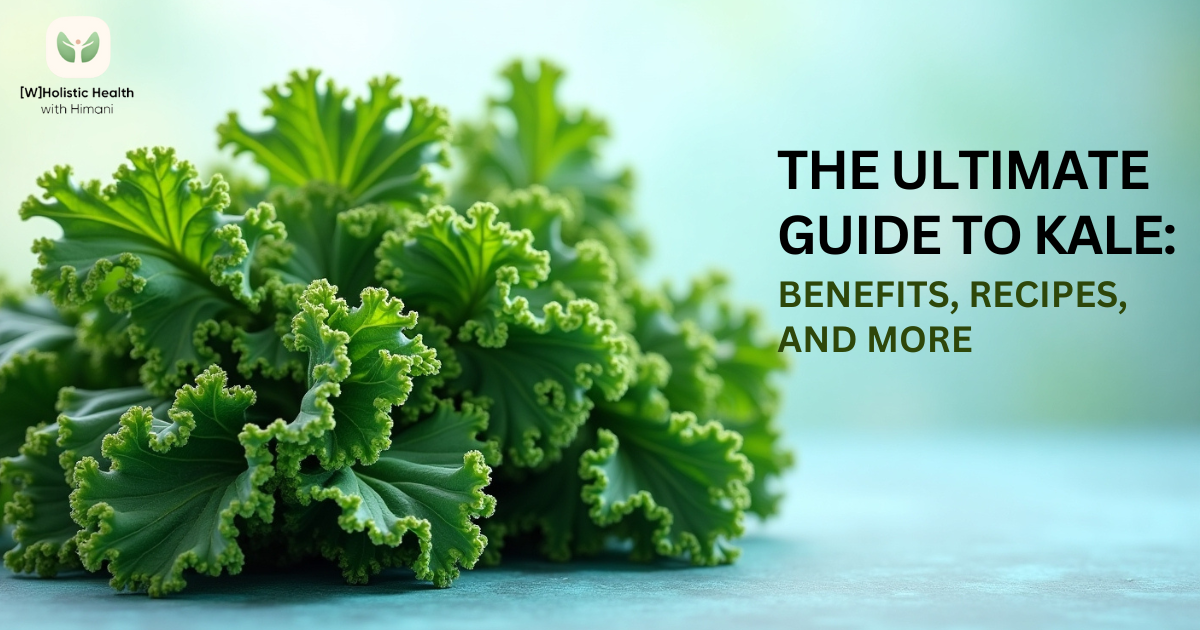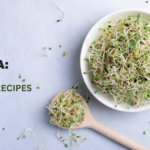Kale is a nutrient-dense leafy green vegetable from the Brassica family, which includes broccoli, cabbage, and Brussels sprouts. Known for its robust flavor and versatility, kale is famous worldwide for its health benefits and culinary uses. It comes in various types, including curly kale, lacinato kale (Dinosaur kale), and Red Russian kale, each with unique textures and flavors. Kale thrives in cooler climates, making it an excellent addition to seasonal diets.
Table of Contents
ToggleWhat are Some Nutritional Benefits of Kale
Kale is a powerhouse of nutrition. One cup of raw kale (about 67 grams) provides:
- Vitamin K: 684% of the daily value (DV), essential for blood clotting and bone health.
- Vitamin A: 206% of the DV, promoting healthy vision and skin.
- Vitamin C: 134% of the DV, boosting immunity and collagen production.
- Calcium: 9% of the DV, supporting strong bones.
- Iron: 6% of the DV, aiding oxygen transport in the blood.
It is also rich in antioxidants like quercetin and kaempferol, which reduce inflammation and protect against oxidative stress.
Read More: Brussels Sprouts: Nutrition, Health Benefits, and Cooking
What are the Different Types of Kale
- Curly Kale: The most common variety with ruffled leaves and a slightly bitter taste.
- Lacinato Kale: Also known as Dinosaur Kale, it has a darker, more delicate flavor, making it ideal for soups and stews.
- Red Russian Kale: Mildly sweet and tender, suitable for salads and smoothies.
- Redbor Kale: Purple-hued and decorative, perfect for garnishes and vibrant dishes.
What are the Health Benefits of Kale?

Kale offers numerous health benefits:
- Supports Heart Health: Rich in potassium and magnesium, kale helps regulate blood pressure and promotes cardiovascular health.
- Strengthens Bones: High calcium and vitamin K content aid in maintaining bone density and preventing osteoporosis.
- Boosts Eye Health: Antioxidants like lutein and zeaxanthin protect against macular degeneration and cataracts.
- Aids Detoxification: Sulfur compounds in kale support liver detox processes and promote toxin elimination.
- Supports Weight Loss: Low in calories and high in fiber, kale helps maintain fullness while providing essential nutrients.
- Promotes Digestion: Its fiber aids digestion and promotes a healthy gut microbiome.
Kale for Weight Loss
Kale is ideal for weight loss due to its low-calorie density and high fiber content. One cup of kale has only 33 calories but provides nutrients that promote satiety and energy. Incorporating kale into smoothies, soups, or salads can help control appetite while delivering essential vitamins and minerals.
Read More: Spirulina 101: Nutritional Benefits, Uses, and Expert Tip
Kale for Skin
Kale’s high vitamin C content supports collagen production, maintaining skin elasticity and reducing signs of aging. Its antioxidants help combat free radicals, reducing skin damage. Vitamin A in kale contributes to a clear complexion and prevents dryness.
Kale for Cancer Prevention
Kale contains glucosinolates, compounds that convert into cancer-fighting agents when consumed. According to studies, these compounds help detoxify carcinogens and protect against the development of cancer cells. The high antioxidant levels in kale further reduce oxidative stress, a known factor in cancer progression.
Kale for Diabetics
Kale benefits diabetics due to its low glycemic index and high fiber content, which helps regulate blood sugar levels. Its alpha-lipoic acid has been shown to improve insulin sensitivity and reduce oxidative stress in individuals with diabetes.
Kale for Eye Health
Kale is rich in lutein and zeaxanthin, antioxidants that support eye health by filtering harmful blue light and reducing the risk of macular degeneration and cataracts. These nutrients also help maintain overall vision quality as we age.
How Does Kale Impact Digestion?
Kale’s high fiber content promotes bowel regularity and supports healthy gut bacteria. Its prebiotic properties help nourish beneficial gut microbes.
Does Kale Make You Gassy?
Kale can cause gas in some individuals due to its fiber and raffinose content. Cooking kale reduces these effects.
Can Kale Help With Bloating?
Yes, kale’s fiber content can alleviate bloating by improving digestion and promoting a healthy gut.
What are Some Easy Kale Recipes to Make at Home?
Kale Smoothies
Kale smoothies are a delicious way to incorporate this superfood into your diet. Blend kale with fruits like bananas, apples, or berries to mask its bitterness and create a nutrient-packed drink. Adding a spoonful of nut butter or chia seeds can enhance the flavor and nutritional value.
Read More: What a Nutritionist Says About Acai’s Health Benefits
Example Recipe:
- 1 cup kale leaves (stems removed)
- 1 banana
- 1/2 cup frozen pineapple
- 1 cup almond milk
- Blend until smooth and enjoy.
Kale Chips Recipe
Kale chips are a healthy alternative to traditional snacks. Here’s a simple recipe:
- Preheat your oven to 350°F (175°C).
- Wash and dry kale leaves thoroughly.
- Tear kale into bite-sized pieces and remove stems.
- Toss with olive oil and a pinch of salt.
- Spread on a baking sheet in a single layer.
- Bake for 10–15 minutes until crispy.
How to Incorporate Kale Into Your Diet
Kale is versatile and can be prepared in many ways:
- Raw in Salads: Massage with olive oil and lemon juice to soften and reduce bitterness.
- Smoothies: Blend kale with bananas, apples, and citrus for a nutrient-packed drink.
- Soups and Stews: Add chopped kale towards the end of cooking for added texture and nutrition.
- Stir-fries: Sauté kale with garlic and soy sauce for a quick side dish.
- Baked Kale Chips: Toss kale with olive oil and seasoning, then bake for a healthy snack.
Easy Kale Recipes for Beginners
- Kale Caesar Salad: Toss massaged kale with Caesar dressing, croutons, and Parmesan for a flavorful dish.
- Kale Smoothie: Blend kale with pineapple, coconut water, and ginger for a refreshing drink.
- Kale and Sweet Potato Hash: Sauté sweet potatoes, onions, and kale for a hearty breakfast.
- Kale Soup: Add kale to a pot of simmering lentils, tomatoes, and vegetable broth.
- Kale Chips: Bake kale leaves at 350°F for 10 minutes after seasoning with olive oil and salt.
Kale for Breakfast
Kale is an excellent addition to breakfast dishes. Add sautéed kale to omelets, mix it into scrambled eggs, or blend it into a morning smoothie. Its nutrients provide a healthy start to the day, enhancing energy and focus.
Cooking Tips for Kale
- Remove tough stems for a more tender texture.
- Pair kale with acidic ingredients like lemon or vinegar to balance its bitterness.
- Lightly steam or sauté kale to retain nutrients while enhancing flavor.
- Store kale in the fridge with a damp paper towel to maintain freshness.
How To Grow and Harvest Kale
How to Grow Kale in Your Backyard
Kale thrives in well-drained, fertile soil with a pH of 6.0–7.5. Plant seeds 1/2 inch deep and 18 inches apart in rows. Water regularly and ensure 6–8 hours of sunlight daily. It is frost-tolerant and develops a sweeter flavor after exposure to light frosts.
Best Time to Plant Kale
Plant kale in early spring or fall. In cooler climates, it can be grown year-round.
How to Harvest Kale Leaves
Harvest outer leaves when they are 4–5 inches long. Leave the central bud to encourage continuous growth. Regular harvesting promotes higher yields.
Common Issues When Growing Kale
- Pests: Watch for cabbage worms, aphids, and flea beetles.
- Diseases: Prevent black rot and clubroot by practicing crop rotation and using disease-resistant varieties.
Organic Methods for Growing Kale
- Enrich the soil with compost.
- Use companion plants like marigolds to deter pests.
- Apply neem oil or insecticidal soap for pest control.
How to Store and Preserve Kale
How to Store Kale in the Fridge
Place kale in a breathable bag with a damp paper towel in the crisper drawer. Avoid washing until ready to use. Stored properly, kale stays fresh for up to a week.
Can You Freeze Kale?
Yes, kale freezes well. Wash, chop, and blanch kale before freezing to preserve its texture and nutrients. Store in airtight bags for up to six months.
How to Blanch Kale for Freezing
- Bring a pot of water to a boil.
- Submerge chopped kale for 2 minutes.
- Transfer to ice water immediately.
- Drain and pat dry before freezing.
Creative Ways to Use Frozen Kale
- Add directly to soups and stews.
- Blend into smoothies for a quick nutrition boost.
- Use it as a pizza topping or in casseroles.
Debunking Common Kale Myths
- Is Kale Overrated? Kale’s nutrient density and versatility make it a valuable addition to most diets.
- Is Kale Bad for You? In moderation, kale is safe and beneficial. Excessive consumption may affect thyroid function due to goitrogens.
- Does Kale Contain Protein? Yes, kale provides nearly 3 grams of protein per cup.
- Does Kale Cause Gas? While some individuals may experience gas, cooking, and proper preparation reduce this risk.
Kale in Different Cultures
- Ireland: Colcannon combines mashed potatoes with kale for a traditional dish.
- Portugal: Caldo Verde is a classic soup featuring kale and chorizo.
- Germany: Grünkohl mit Pinkel pairs kale with sausages for a hearty meal.
- Mediterranean Cuisine: Kale is added to salads, sautéed dishes, and pizzas.
- South Asia: Kale is stir-fried with spices or added to lentil soups.
Who Should Avoid Kale?
Individuals with certain health conditions should limit kale consumption:
- Thyroid Disorders: Goitrogens in raw kale can interfere with thyroid function.
- Kidney Issues: Kale’s high potassium content may not be suitable for those with kidney disease.
- Anticoagulant Users: Kale’s high vitamin K levels can interfere with blood-thinning medications.
Conclusion
Kale is a nutrient-packed superfood offering numerous health benefits, from boosting immunity to supporting heart and bone health. Its versatility in cooking makes it a valuable addition to any diet. Whether raw in salads, blended into smoothies, or sautéed as a side dish, kale is a delicious and nutritious way to enhance your meals. With proper storage, preparation, and understanding of its benefits, kale can be a staple in a healthy, balanced diet.

I’m Himani, a Singapore-based health coach certified by IIN. I help clients create personalized nutrition and lifestyle plans that lead to lasting health goals. By focusing on individual needs, I provide actionable steps to support your journey to optimal well-being











